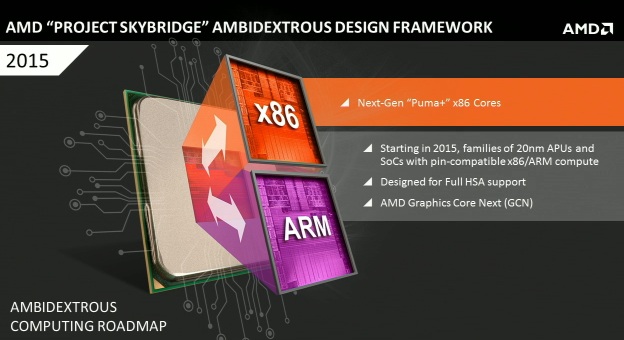AMD Details 'Ambidextrous' Solution That Bridges x86, ARM
AMD is hoping to merge the x86 and ARM ecosystems with 'ambidextrous computing.'
AMD today hosted an innovation update for investors and members of the press to talk about how it’s realigning its strategy based on a new solution called 'ambidextrous computing.' The company has been working on this solution for two years and the end result is an ARM-based SoC that is pin compatible with AMD’s next-gen x86. Dubbed Project Skybridge, this will allow users to have a motherboard that runs ARM and x86.
This design framework is a family of products on the 20nm process and will use Puma+ on the x86 side and A57 on the ARM side. It’ll feature HSA as well as AMD GCN (Graphics Core Next) and will be Android compatible -- a first for AMD. Though AMD’s meeting today was heavy on Seattle and what it means for the server market, the company has said that Skybridge will target the client/embedded markets for 2015, with nothing for servers.
AMD also talked briefly about its plans for 2016, which will see the company debut its own custom-developed 64-bit ARM core design. The company didn’t offer much in the way of information but did tell us that this 64-bit ARMv8 CPU core will be in servers and embedded solutions along with semi-custom and ultra low power client devices. We’ll also see a matching x86 design around the same time. Again, not a whole lot of information on that right now, but we'll keep you posted.
Follow Jane McEntegart @JaneMcEntegart. Follow us @tomshardware, on Facebook and on Google+.
Get Tom's Hardware's best news and in-depth reviews, straight to your inbox.

Jane McEntegart is a writer, editor, and marketing communications professional with 17 years of experience in the technology industry. She has written about a wide range of technology topics, including smartphones, tablets, and game consoles. Her articles have been published in Tom's Guide, Tom's Hardware, MobileSyrup, and Edge Up.
-
hannibal x86 + arm + gcn + hsa + hUMA + trueaudio + etc...Reply
A lot of integrated action in there. Hopefully it will go well. Probably it remains unused opportunity... There are so many things that requires full implementation by programmers, that it is almost scary thing to think about. All good ideas that only need support from program developers.
-
Akizu Somehow I don't see how this is supposed to work... What does "pin-compatible" mean? If its just being able to put either x86 or ARM processor into the mobo then its useless... If you can have both and switch between them then this may have some uses but its still quite useless... If those two processors will be able to work side by side that's the only cease when this would be somewhat useful, but only once we have an operating system that would support this...Reply -
CSick19 Is this just a SOC with separate x86 and ARM CPUs built in? Or is it really a processor that is compatible with both architectures? In other words, is half the chip just unused all of the time?Reply -
joaompp This is counter productive, what we need is an architecture that can run both instruction sets with very little overhead ... OR traditional desktop OSes need to migrate to support ARM processors .... OR mobile OSes need to abandon the ARM architecture . Short of any of these 3 options, it's all short term solutions.Reply -
knowom So I guess this implies the possibility of enthusiast CPU coolers for ARM which if that's the case AMD has a winner up it's sleeve.Reply -
photonboy Very confusing article, but I believe they just mean an upcoming SOCKET will be compatible with either x86 or ARM. So you can use the same motherboard for either.Reply
I guess this could lower manufacturing costs a bit, but it doesn't seem like a big deal to me. -
joaompp Reply13237130 said:Very confusing article, but I believe they just mean an upcoming SOCKET will be compatible with either x86 or ARM. So you can use the same motherboard for either.
I guess this could lower manufacturing costs a bit, but it doesn't seem like a big deal to me.
what they mean is that the chip will have both an x86 cpu ....and.... an ARM cpu on the same die, the ARM cpu will be an A57 so that should give an idea of performance.
